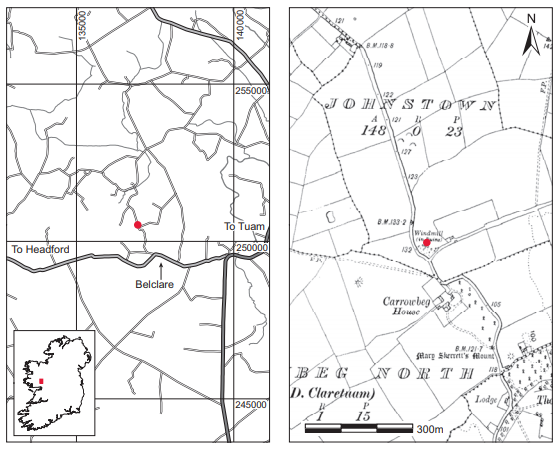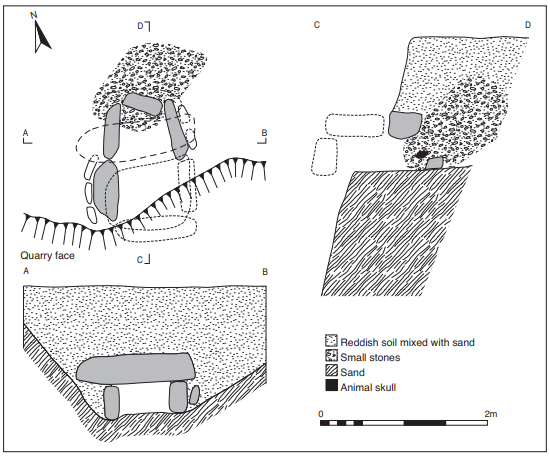County: Galway Site name: JOHNSTOWN, CO. GALWAY
Sites and Monuments Record No.: SMR GA043-093001 Licence number: —
Author: ÉTIENNE RYNNE
Site type: Early Bronze Age graves
Period/Dating: —
ITM: E 536939m, N 750482m
Latitude, Longitude (decimal degrees): 53.500559, -8.950489
Introduction
In late November 1968, during work in a sand quarry near Belclare, Co. Galway, a short cistlike structure was discovered. During the previous night the quarry face had collapsed, revealing the structure. It lay approximately 0.9m below the top of the quarry and consisted of two edge-set stones placed parallel to each other about 0.6m apart, with a third stone resting on them. It was clear from some large stones found at the bottom of the quarry face below that part of the structure had fallen away with the sand. The site was first reported to the Department of Archaeology, University College, Galway, and then to the NMI. It was investigated by Professor Étienne Rynne.115 This report is based on Professor Rynne’s illustrations and account of the excavation.


Location (Fig. 3.74)
The site was in the townland of Johnstown, north Co. Galway, between Tuam and Headford.116 It was in the southern part of a field that also contained a windmill (in ruins) and was located just east of this site. The ‘cist’ structure lay in the face of a sand quarry at an altitude of 30–60m above sea level.
Description of site
When excavated, the remains of the structure consisted of four stones set on edge forming a rectangular cist structure, aligned north-north-east/south-south-west and capped by two stones.117 Internally the remaining portion measured 1.2m long by 0.6m wide by 0.34m high (Fig. 3.75). If the three stones at the bottom of the quarry were originally part of the structure, it would have measured 1.24m long by 0.72m wide by 0.34m high. The cist would then have been formed of six side stones, two at each side and one at each end, and would have been covered by three capstones. The northern end stone of the cist (i.e. that which remained in the section) was only 0.15m high and was thus not functional in that it did not close the end of the structure. Investigation, furthermore, showed that at some stage long subsequent to the construction of the cist this northern end had been badly disturbed by a deep hole dug into it from above. A small capstone at this end was probably removed, and the hole was filled with small rounded stones, among which an animal skull and some animal bones were found, possibly those of a sheep. The floor of the cist was not paved. It had been built in a pit with widely sloping sides and then covered over with mixed soil (reddish in colour) and sand. The cist slabs rested on sand, two of those remaining having packing stones outside them.
Comment
No human bone or artefacts were found in the cist. Had the cist contained a burial, it is possible that the remains collapsed with the stones and were covered with sand at the base of the quarry. Owing to the absence of artefacts or human bones, it cannot be stated with certainty that this structure was a cist grave, although the excavator was inclined to think that it was. Waddell (1990) does not list this site. Although it is unusual to have more than one capstone, other early Bronze Age examples have been recorded. Animal remains have also been found in some cists but are, relatively speaking, uncommon. Given that it was suggested that the bones and skull may have belonged to a sheep, perhaps a modern burial of a sheep disturbed the northern end of the cist. Another possibility is that the site was a long rather than a short cist, but the construction resembles a Bronze Age cist more than any later type of slab-lined or lintel grave.
115. Professor Rynne was assisted in the investigation by Mr Cunningham, Mr Murphy and three students of archaeology at University College, Galway—Ms Anne Gannon, Mr Martin Timoney and Mr Patrick Wallace.
116. Parish of Killower, barony of Clare. SMR GA043-093001— (the site is listed in the SMR as ‘Cist, possible’). IGR 136975 250459.
117. All of the stones of the structure were of limestone.